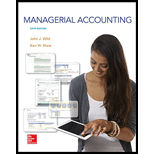
Concept explainers
Concept introduction:
Fixed budget is based on a single predicted amount of sales or production volume; unsuitable for evaluations if the actual volume differs from the predicted volume.
Price variance is the difference between actual and budgeted sales or cost caused by the difference between actual price per unit and the budgeted price per unit.
Quantity variance is difference between actual and budgeted costs caused by the difference between the actual quantity and the budgeted quantity.
Volume variance is the combination of both overhead spending variances (variable and fixed) and the variable overhead efficiency variance.
Controllable variance is difference between the total budgeted overhead cost and the overhead cost that was allocated to products using the predetermined fixed overhead rate.
Cost variance is difference between actual cost and standard cost, made up of a price variance and a quantity variance.
Flexible budget is prepared on predicted amounts of revenues and expenses corresponding to the actual level of output.
Management by exception is the management process to focus on significant variances and give less attention to areas where performance is closed to the standard.
Requirement:
Identifying terms with their corresponding definition.
Want to see the full answer?
Check out a sample textbook solution
Chapter 8 Solutions
Managerial Accounting
- Solvearrow_forwardA local bakery sells 12,000 loaves of sourdough bread each year. The loaves are ordered from an outside supplier, and it takes 4 days for each shipment of loaves to arrive. Ordering costs are estimated at $18 per order. Carrying costs are $6 per loaf per year. Assume that the bakery is open 300 days a year. What is the maximum inventory of loaves held in a given ordering cycle? Solutionarrow_forwardHello tutorarrow_forward
- A local bakery sells 12,000 loaves of sourdough bread each year. The loaves are ordered from an outside supplier, and it takes 4 days for each shipment of loaves to arrive. Ordering costs are estimated at $18 per order. Carrying costs are $6 per loaf per year. Assume that the bakery is open 300 days a year. What is the maximum inventory of loaves held in a given ordering cycle?arrow_forwardGiven solution for General accounting question not use aiarrow_forwardPlease provide correct solution and accounting questionarrow_forward
- Answer? ? Financial accounting questionarrow_forwardWhat is the maximum inventory of places held in a given ordering cyclearrow_forwardA local bakery sells 12,000 loaves of sourdough bread each year. The loaves are ordered from an outside supplier, and it takes 4 days for each shipment of loaves to arrive. Ordering costs are estimated at $18 per order. Carrying costs are $6 per loaf per year. Assume that the bakery is open 300 days a year. What is the maximum inventory of loaves held in a given ordering cycle? need your helparrow_forward
- What is the machine's book value at the end of 20X4?arrow_forwardAccounting solutionarrow_forwardA local bakery sells 12,000 loaves of sourdough bread each year. The loaves are ordered from an outside supplier, and it takes 4 days for each shipment of loaves to arrive. Ordering costs are estimated at $18 per order. Carrying costs are $6 per loaf per year. Assume that the bakery is open 300 days a year. What is the maximum inventory of loaves held in a given ordering cycle?arrow_forward
- Principles of Accounting Volume 2AccountingISBN:9781947172609Author:OpenStaxPublisher:OpenStax College
 Survey of Accounting (Accounting I)AccountingISBN:9781305961883Author:Carl WarrenPublisher:Cengage Learning
Survey of Accounting (Accounting I)AccountingISBN:9781305961883Author:Carl WarrenPublisher:Cengage Learning


